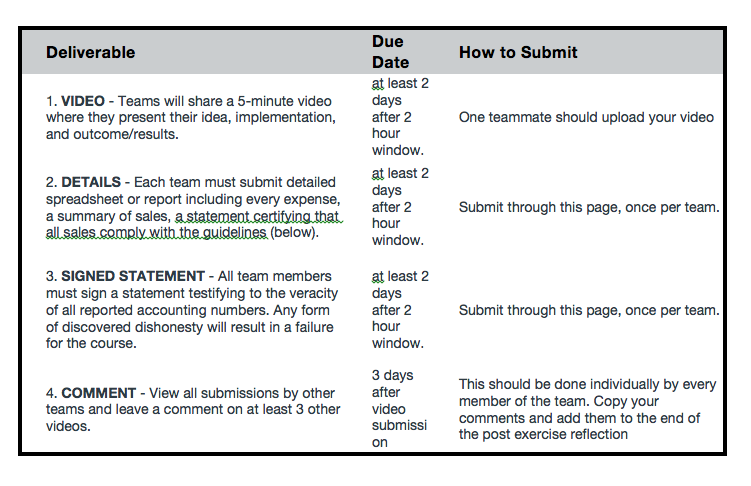Business Exercise Starts with $5 in Seed Money

Downloads
Given just $5 in seed money, student teams learn to form partnerships and leverage networks...and how constraints can actually make them more creative.
Effectual reasoning, a form of expert entrepreneurial decision making, provides a series of decision making strategies for individuals in low-power situations. In these situations, individuals must leverage inalienable assets to accomplish goals (Sarasvathy 2009). The process begins with students identifying these assets by asking themselves “Who I am, what can I do and who I know.”
This exercise teaches effectual reasoning by forcing the students into a scenario where effectual reasoning leads to the best outcomes because students are allowed only limited access to inalienable assets, in this case cash. Seed money is just $5 per team. The exercise demonstrates how constraints can lead to creative solutions to problems as well (Craft and Jeffrey 2008).
The exercise then allows the opportunity to teach the three foundations of effectuation: affordable loss, strategic partnerships and leveraging contingencies. The affordable loss is built into the exercise with the limited seed money. Students are encouraged to form partnerships due to the cash flow restrictions described below. This forces students to leverage their networks and create partnerships to further their goals. Finally, it is common for unexpected events to happen when conducting the exercise, and hence this allows a better understanding of the leveraging contingency idea.
If may be possible to also impart a deeper understanding of the creation of new ideas and spaces through partnerships, per (Sarasvathy and Dew 2005).
The background reading for the students is (Sarasvathy 2001), also published as Case No. UVA-ENT-0065. 9/13/2005. Darden Business Publishing, (9 pages). and (Sarasvathy and Dew 2007) It is possible to pair the cold opportunity case: Cold Opportunity (A): The Nils Bergqvist Story. UVA-ENT-0119; Cold Opportunity (B): The ICEHOTEL Story.
Inspiration for this idea comes from Tina Seelig (https://www.youtube.com/watch?v=VVgIX0s1wY8)
How it Works
This exercise can be used in three ways:
- As an introductory challenge. Students can be put into teams on the first day of class, and then expected to do this exercise over the first weekend. Sometimes this is difficult as assigned teams can be affected by students dropping the course prior to the drop deadline.
- Alternatively, the exercise can implemented right after the drop deadline, and the first two weeks can be used to teach fundamentals of effectuation – in particular how value can be derived from “who I am”.
- The exercise can also be implemented as a course capstone, incorporating many of the lessons from a course.
The Basics: You have been randomly allocated to a team of three individuals. Your goal is to earn as much money as you can within the hours that the business will be open. You may plan as much as you want, but once you begin, your business can only be open for agreed-upon business duration. Seed funding for your venture is enclosed in the envelope you received. Profits (if any) will be split between team members and can be used as seed money for your next venture. Profits are all revenues minus any cash expenses.
Deliverables: You have four deliverables for this challenge. A failure to submit these items will result in 0 points. Note to Instructors: the strict requirement is enforced due to the dependency across the teams. Students need to be able to view other submissions, and hence this is done to ensure that late assignments do not impact other students. In a large class, it could be relaxed given that most will comply and there will be sufficient videos for others to view.

Guidelines:
- This is an educational experience.
- The business duration will be 1, 2 or 3 hours. The class will vote on this duration when the teams are announced. Note to instructors: This feature isn’t strictly necessary and the default should be 2 hours. The vote gives the students agency and ownership, but the effect is probably not large.
- You are expected to sell something for money.
- You will operate a live business during the business duration. All transactions must be made in this time period. Any sales occurring outside this time period are not penalized, but they do not count towards your final profits.
- You may use any gear or equipment that you own, but if you choose to sell objects, any consumables must be procured with money invested in your venture. For example, you may use a computer or camera you own. However, you may not sell the contents of your kitchen, or go to, say, Costco and buy items to sell for more than your seed investment.
- All seed money is either a loan or equity. If you accept the seed money, you can choose which type of investment you want.
- You may choose not to accept the seed money. However, you may not take on any additional funding from any sources. Note to instructors: It is rare for students to reject the seed money, though many discover that the seed money is not very helpful.
- If you accept the money as a loan, it is loaned at a 10% rate through the end of the exercise – that is, you must return the seed money + 10% - and this money is deducted from the team’s profit. If the team does not earn enough to cover the seed financing, the debt is forgiven.
- If you accept it as equity, you must return 10% of your profits at the end of the exercise. What you return counts against your profit total. Note to instructors: In general, the investments generate positive returns in aggregate - unless all the savvy teams choose loans. It is sometimes hard to produce the cash funds with anything but personal funds. I keep a dedicated cash kitty for this exercise from year to year.
Tips: Successful projects will have the following characteristics
- The idea will leverage a skill or characteristic that you as the entrepreneur have. Be effectual!
- The idea will have to be feasible. As such, it will need to be relatively simple. The business is only open for 1,2, or 3 hours, and you have few days to plan.
Grading: Teams will be ranked based on the amount of profit they produce. Up to 125 points towards your final grade are available and will be awarded according to the attached rubric. Points for rank will be distributed as follows:
- Top team: 50 points
- Second team: 45 points
- Third team: 40 points
- Fourth team: 35 points
- Fifth team: 30 points
- Sixth team: 25 points
- Seventh team+: 20 points
- 0 points if no reasonable efforts to make a sale are made, or if not all deliverables are submitted on time.
Note to instructors: 100 points is approximately 5%-7% of the final grade. That is, students who perform poorly may lose up to 1.5% of their final grade. However, the strict ranking system above serves to motivate students in a strong way.
Pre Exercise Reflection (10 points)
Note: this is graded per the reflection rubric attached.
Note to instructors: I collect these via our learning management system and use a simple rubric (below) to grade them.
During class time, you should have received a copy of the Pop-Up Business Challenge
Prior to embarking on this challenge, answer the following questions in your own words:
- How do you and your team plan to generate profits from the seed money given to you?
- Do you think your team’s business idea will be successful? Why?
- Explain how your plan is effectual.
Post Exercise Individual Reflection
Note: this is graded per the reflection rubric attached.
Note to instructors: I collect these via our learning management system and use a simple rubric (attached) to grade them).
Learn from Others: Remember to view all video submissions by other teams and leave a comment on at least 3 other videos.
This should be done individually by every member of the team. Copy your comments and submit them here as well as answering the following questions.
Reflect on Your Experience: (10 points) Answer the following questions in your own words:
- How did you come up with your idea?
- What were your total earnings (revenue – cost)?
- Explain how you were effectual. Could you have been more so? Explain.
- What did you learn from this exercise? How would your answer change if you had received $500 instead of $5 as seed money?
Notes to Instructors
In general, the best ideas leverage partnerships to get around the $5/constraint. For example, one team leveraged their photography talent and took their camera to an entrepreneurship fair and offered headshots. They convinced the fair sponsors to give them space for free. Another team entered stores that served college students and asked for donations or excess supply that he could sell. This student set up an online store to sell what he collected (earning $700). One team partnered with an organic strawberry farmer and offered to sell to people in their local network during a two-hour period. Usually, the low-performing teams will choose to use the cash to buy ingredients for cookies or the like. One team went to Costco and bought bottled water to sell to drunk people after they exited bars on a weekend night. Since they asked for donations as opposed setting a price, some people were very generous.
The most important principle is that the teams can never be cash flow negative. This implies that they need to come up with creative ways around the $5 constraint. The most common is to create a partnership with some existing entity to give them access to a resource for free, or to allow payment for inventory only after cash has been received. This requires effectual deal making. Thus, if exceptions are made for investments it will undermine the point of the exercise.
The second question that comes up is whether the product or service must be supplied during the 2 hours. For example, if students want to sell items on spec, and then produce them afterwards. This is allowed under the rules above (all money must change hands during the two hours). However, depending on the students, it is sometimes helpful to put a constraint on the time it will take to provide the services. For example, one group of MBA students once sold 6 months of bookkeeping / payroll management services to three small businesses for $27,000. This occurred when the project was served as a capstone to an entire course, and planning extended over weeks. Delivery of the services was over 6 months, but the money was collected upfront in a 2-hour period (this is very exceptional). Limiting the timespan of delivery has the benefit of not rewarding those students/teams who are willing to engage in this type of post-class time investment.
Students who are selling things face to face quickly realize that they need to refine their sales pitch. This is an important lesson, though it tends to only happen with the immediate interpersonal feedback.
One of the most surprising parts of conducting this exercise across many cohorts is that some students have never sold anything, even if they are quite senior in the business world. Many found this empowering, and others found it profoundly uncomfortable. This discomfort can lead to strong reactions from some students. In my mind, this is what the exercise does best. It allows students to feel what it is like to be an entrepreneur, and encounter uncertainty and ambiguity, but also what it feels like to sell something. It allows self discovery.
References
Craft, Anna, and Bob Jeffrey. 2008. “Creativity and Performativity in Teaching and Learning: Tensions, Dilemmas, Constraints, Accommodations and Synthesis.” British Educational Research Journal 34 (5). Blackwell Publishing Ltd:577–84.
Sarasvathy, Saras D. 2001. “What Makes Entrepreneurs Entrepreneurial?” https://papers.ssrn.com/sol3/papers.cfm?abstract_id=909038.
———. 2009. Effectuation: Elements of Entrepreneurial Expertise. Edward Elgar Publishing.
Sarasvathy, Saras D., and Nicholas Dew. 2005. “New Market Creation through Transformation.” Journal of Evolutionary Economics 15 (5). Springer-Verlag:533–65.
Additional Search Terms: entrepreneurship courses, teaching ideas, teaching resources, classroom ideas, entrepreneurship classes, business schools, business school classes, entrepreneurship students, professors





